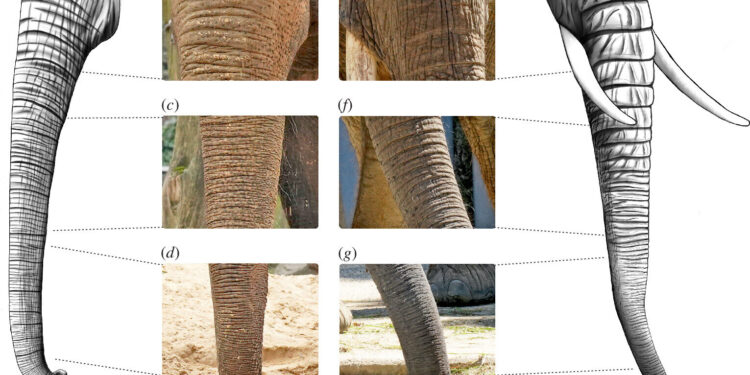Asian (E. maximus) and African (L. africana) elephants differ in trunk morphology, including trunk wrinkles. Illustrations (a, h): Cindy Ritter. Photo credit (b–d): Lena Kaufmann, Humboldt Universität zu Berlin; Zoologischer Garten Berlin, Berlin, Germany. Photo credit (e–g): Lena Kaufmann, Humboldt Universität zu Berlin; Schönbrunn Zoo, Vienna, Austria. Credit: Royal Society Open Science (2024). DOI: 10.1098/rsos.240851
A multidisciplinary team of scientists conducted a study of Asian and African elephant wrinkles to learn more about their function. In their study, published in the journal Royal Society Open ScienceThe group studied zoo animals, museum specimens and photographs to learn more about the development and purpose of elephant wrinkles.
Previous research has shown that the elephant’s trunk is a remarkable anatomical structure: made up of some 46,000 muscles, it can be bent, turned, twisted and beaten depending on its owner’s needs. Its tip is also movable, acting like a hand or hook to help retrieve food.
Wrinkles are less well studied when it comes to an elephant’s trunk and rest, noted the researchers of this new effort. Elephants have wrinkles on most parts of their bodies, but they are most visible on their legs and especially their trunk.
To learn more about the reason for these wrinkles, the research team studied how Asian and African elephants in zoos moved and used their trunks. They also examined preserved tissues and studied photographs of elephants still in their mothers’ wombs. By placing these photographs together to form a timeline, they were able to track the development of the wrinkles.
The research team discovered that the wrinkles develop while elephants are still in the womb; animals become more and more wrinkled as they age. They perform a specific function on the trunk, assisting with shape changing and lifting objects.
While observing elephants, researchers also discovered that they possessed a “trunk,” in which individuals preferred to curl or wrap their trunks around an object coming from the same direction. Their preference results in physical adaptations to the trunk. There were more wrinkles on the curved side of the trunk to help hold objects and shorter whiskers on the opposite side of the trunk as they were continually scraped against the ground.
More information:
Andrew K. Schulz et al, Elephants develop wrinkles through both form and function, Royal Society Open Science (2024). DOI: 10.1098/rsos.240851
© 2024 Science X Network
Quote: Scientists study elephant wrinkles to understand their function (October 9, 2024) retrieved October 9, 2024 from
This document is subject to copyright. Except for fair use for private study or research purposes, no part may be reproduced without written permission. The content is provided for informational purposes only.



